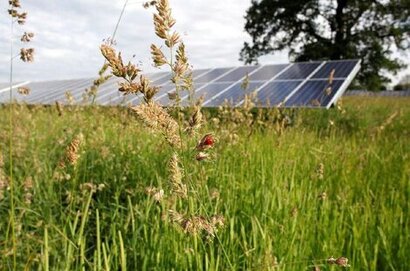
The report was launched at the trade association’s first ever parliamentary reception earlier this week, opened by Edward Morello MP. Produced in collaboration with Lancaster University and ecological consultancies Wychwood Biodiversity and Clarkson & Woods, the report is based on data collected from an unprecedented number of sites. A total of 124 solar farms submitted data, up from 87 last year and 37 when the report was launched in 2023
“Solar doesn’t stop at just providing renewable energy [but has] real biodiversity benefits” said Mr Morello.
The total number ever surveyed for the Solar Habitat initiative now stands at 248. As the data set grows and an increasing number of sites are monitored regularly, long terms trends will hopefully become an additional feature of future reports.
“Three years ago, we knew anecdotally that solar farms were good for wildlife said Solar Energy UK Chief Executive Chris Hewett. “The evidence is strong now. We are starting to see clear benefits for biodiversity, with over 50 percent of sites seeing red-listed birds.”
The average age of the sites surveyed last year and reported now is nine years, the same as the national average. Their locations broadly mirror the national distribution, with an average size of 16 hectares almost matching the national average of 14ha.
Solar farms’ increasingly important roles in the natural environment are perhaps best exemplified through Solar Habitat’s bird surveys, undertaken across 63 solar farms. They recorded an average of 86 birds per site (up to 238 in one instance), with the number of species seen ranging from nine to 39.
Among them were the red-listed nightingale, seen during two surveys of one solar farm and reported as a possible breeding site. Its population has plummeted in recent decades, attributed to the degradation and loss of the scrubby woodland habitat in which they breed. The iconic songbird is now restricted to a few patches of southern and eastern England.
Cirl bunting was also observed at one site. The species’ range is now only 15 percent of what it was 50 years ago, with only a small strip of south Devon and Cornwall left.
Skylark, yellowhammer and linnet – again, all red-listed – were also commonly observed by ecologists.
The report very much agrees with an RSPB and University of Cambridge study from earlier this year, which found that well managed solar farms can support biodiversity.
They found that the abundance and species richness of birds on six East Anglian solar farms were greater where mixed habitats were present – either due to greater floral diversity compared to more intensively managed solar farms or arable land, or through providing structural variety through cover and perches. Thus the effects of solar farms may differ depending on whether they are deployed in areas intensive arable agriculture or those that already contain diverse grasslands or other natural habitats.
As Solar Habitat states, the study, “echoes the notion that solar farms can provide relief for birds from the impacts of intensive agricultural practices in the surrounding landscape.”
“We often hear that solar is a trade-off with nature, which is simply not the case” added Energy Minister Michael Shanks MP. “Solar power is a fundamental part of our clean power ambitions, strengthening our energy security and protecting bill payers, whilst supporting nature, farmers and local communities.”
Most solar farms monitored last year were assessed for how on-site habitats are managed. More than half were assigned to ‘category 3’, indicating some consideration of biodiversity, with a greater focus being demonstrated at 30 percent of sites, assigned to category 2. The remainder were placed in category 4.
None were placed in the top division, largely due to the practical challenges of removing grass after cutting, which encourages greater plant diversity and thus that of wildlife. Specialist machinery is often required for it, which the report explores in a case study.
As may be expected, there were clear links between site management and biodiversity, with category 2 sites having the greatest richness in invertebrate, plant and bird species. There was also an evident correlation between plant and invertebrate species richness.
In parallel, a more detailed categorisation system is being trailed, describing the management of hedgerows, field margins and grassland around the panels individually. Two thirds of hedgerows were given the top management rating.
The data supplied by the consultancies complies with the Standardised Approach to Monitoring Biodiversity on Solar Farms, which was updated earlier this year. For the first time, some information was provided by a third-party ecological consultant, Envance. It is hoped that a growing number of consultants will submit data to support future reports.
“It was a pleasure to work on the production of the third annual Solar Habitat report” said Harvie Agnew, Senior Policy Analyst – Consents and ESG at Solar Energy UK. “It’s encouraging to see the number of sites growing year on year, a sign of the commitment there is among the site owners to support biodiversity on solar farms and to understand the impact they are having,”
Findings of the report include:
Around 7,500 individual birds were counted, across 94 different species. Of these, 28 percent were Amber Listed, and 20 percent were Red Listed.
Almost 3,000 butterflies and bumblebees were recorded, comprising 29 different species.
Eight species of mammal were recorded, including water voles, common shrew, roe deer and brown hare.
44 different woody plant species were noted.
More than 2,000 quadrats (randomly placed one-metre squares used for ecological surveys) were taken.
314 plant species were recorded.
764 transects were surveyed.
The ecological knowledgebase underpinning Solar Habitat is set to grow even further in the coming years.
Novel automated monitoring technologies are already being trialled at Westmill Solar Park in Oxfordshire to assess the presence of invertebrates, birds and bats, in a study led by Lancaster University. The approach can capture data much more frequently than conventional surveys, which could miss more mobile or rarer species.
The authors are also considering the development of a small number of ‘research intensive’ solar farms, which would enable more frequent monitoring that would overcome the effects of the season and daily weather fluctuations. Volunteer monitoring of birds and invertebrates is also being considered, which should contribute to the richness of the data.
Lastly, Lancaster University has been conducting a deep investigation of the data from 87 sites collected in 2023, which should hopefully the most effective management approaches for promoting biodiversity that have not been picked up already.
For additional information:

